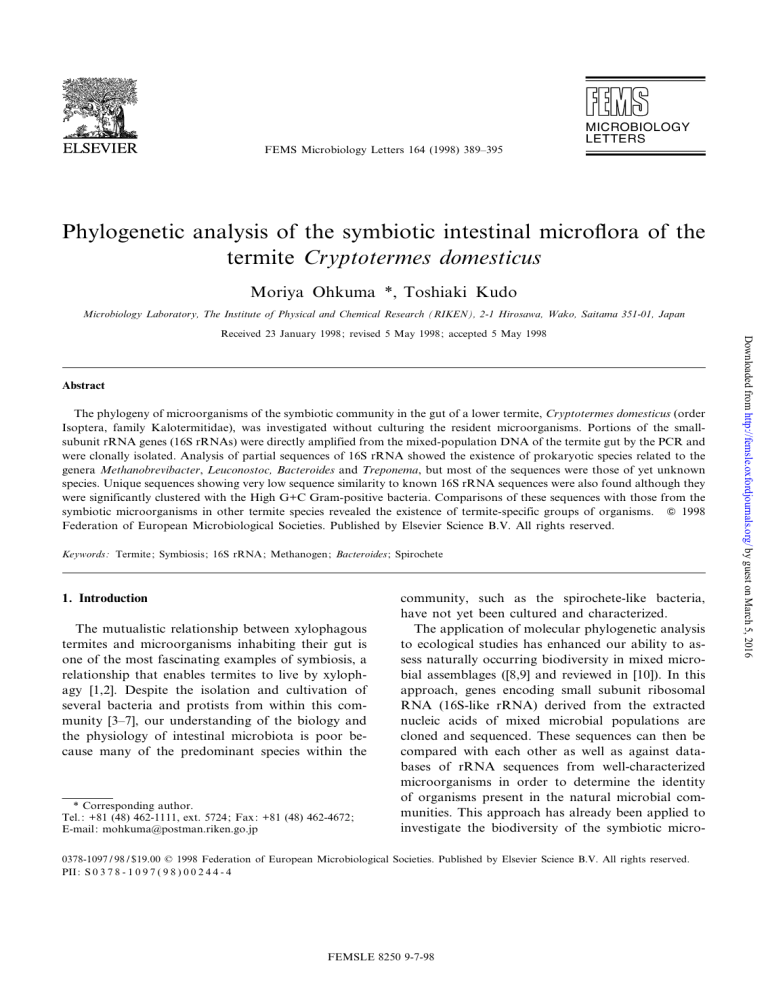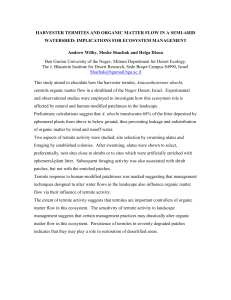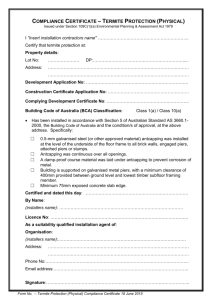
FEMS Microbiology Letters 164 (1998) 389^395
Phylogenetic analysis of the symbiotic intestinal micro£ora of the
termite Cryptotermes domesticus
Moriya Ohkuma *, Toshiaki Kudo
Microbiology Laboratory, The Institute of Physical and Chemical Research (RIKEN), 2-1 Hirosawa, Wako, Saitama 351-01, Japan
Abstract
The phylogeny of microorganisms of the symbiotic community in the gut of a lower termite, Cryptotermes domesticus (order
Isoptera, family Kalotermitidae), was investigated without culturing the resident microorganisms. Portions of the smallsubunit rRNA genes (16S rRNAs) were directly amplified from the mixed-population DNA of the termite gut by the PCR and
were clonally isolated. Analysis of partial sequences of 16S rRNA showed the existence of prokaryotic species related to the
genera Methanobrevibacter, Leuconostoc, Bacteroides and Treponema, but most of the sequences were those of yet unknown
species. Unique sequences showing very low sequence similarity to known 16S rRNA sequences were also found although they
were significantly clustered with the High G+C Gram-positive bacteria. Comparisons of these sequences with those from the
symbiotic microorganisms in other termite species revealed the existence of termite-specific groups of organisms. z 1998
Federation of European Microbiological Societies. Published by Elsevier Science B.V. All rights reserved.
Keywords : Termite ; Symbiosis; 16S rRNA; Methanogen; Bacteroides; Spirochete
1. Introduction
The mutualistic relationship between xylophagous
termites and microorganisms inhabiting their gut is
one of the most fascinating examples of symbiosis, a
relationship that enables termites to live by xylophagy [1,2]. Despite the isolation and cultivation of
several bacteria and protists from within this community [3^7], our understanding of the biology and
the physiology of intestinal microbiota is poor because many of the predominant species within the
* Corresponding author.
Tel.: +81 (48) 462-1111, ext. 5724; Fax: +81 (48) 462-4672;
E-mail: mohkuma@postman.riken.go.jp
community, such as the spirochete-like bacteria,
have not yet been cultured and characterized.
The application of molecular phylogenetic analysis
to ecological studies has enhanced our ability to assess naturally occurring biodiversity in mixed microbial assemblages ([8,9] and reviewed in [10]). In this
approach, genes encoding small subunit ribosomal
RNA (16S-like rRNA) derived from the extracted
nucleic acids of mixed microbial populations are
cloned and sequenced. These sequences can then be
compared with each other as well as against databases of rRNA sequences from well-characterized
microorganisms in order to determine the identity
of organisms present in the natural microbial communities. This approach has already been applied to
investigate the biodiversity of the symbiotic micro-
0378-1097 / 98 / $19.00 ß 1998 Federation of European Microbiological Societies. Published by Elsevier Science B.V. All rights reserved.
PII: S 0 3 7 8 - 1 0 9 7 ( 9 8 ) 0 0 2 4 4 - 4
FEMSLE 8250 9-7-98
Downloaded from http://femsle.oxfordjournals.org/ by guest on March 5, 2016
Received 23 January 1998; revised 5 May 1998; accepted 5 May 1998
390
M. Ohkuma, T. Kudo / FEMS Microbiology Letters 164 (1998) 389^395
2. Materials and methods
2.1. Termites
Wood-eating termites, C. domesticus (Isoptera,
Kalotermitidae), were collected in the Iriomote island, Japan, in July 1996. Termite-infested wood
moistened with distilled water was kept in plastic
boxes at ambient temperature.
2.2. DNA extraction, PCR ampli¢cation, and cloning
Approximately 100 termites were collected and,
after their exterior surfaces were washed with distilled water, their entire guts were removed with forceps. The intestinal contents were gently squeezed
and the gut debris was removed. DNA from the intestinal mixed population were extracted as described
previously [11,12]. Since many termite gut microbes
tightly adhere to the gut wall [14], these populations
may not have been included in the analysis described
here. Ribosomal RNA genes were ampli¢ed from the
puri¢ed DNA by PCR using an ExTaq DNA polymerase (TAKARA) according to manufacturer's
directions. The PCR primers used were described
previously [11] and corresponded to nucleotide positions 519^533 and 1392^1405 of E. coli 16S rRNA.
The reaction conditions were for 35 cycles at 94³C
for 30 s, 45³C for 45 s, 72³C for 2 min. PCRproducts corresponding to the expected size of the
prokaryotic rRNA gene (0.9 kb) were puri¢ed on a
low melting agarose gel using a Wizard PCR preps
DNA puri¢cation system (Promega). The puri¢ed
PCR-products were ligated into a pGEM-T vector
(Promega) according to manufacturer's directions
and then introduced into E. coli. The insertion of
the appropriated size was determined by PCR-ampli¢cation with the universal and reverse primers
(TAKARA) which corresponded to the both sides
of the cloning site on the vector.
2.3. Nucleotide sequencing and phylogenetic analysis
Plasmid DNA was puri¢ed from each clone with a
Wizard mini preps DNA puri¢cation system (Promega) and used as a template for sequencing with the
ABI PRISM Dye Terminator Cycle Sequencing
Ready Reaction Kit with Ampli Taq DNA Polymerase, FS (Perkin Elmer). Sequencing reactions were
determined on an automatic sequence analyzer
(ABI model 373). Sequencing primers, EUB750F
(5P-CRAACAGGATTAGATACCC-3P), EUB900F
(5P-ACTCAAAKGAATTGACGG-3P), EUB1050F
(5P-GGYTGTCGTCAGCTCGTG-3P), EUB1100R
(5P-GGGTTGCGCTCGTTRYGG-3P),
EUB900R
(5P-CGTCAATTCMTTTGAGTT-3P),
EUB750R
(5P-TACCAGGGTATCTAATCC-3P), where R represents A or G, K represents G or T, Y represents C
or T and M represents A or C, were used. These
primers were deduced from consensus regions of eubacterial 16S rRNA. For archaeal 16S rRNA, sequencing primers described previously [12] were
also used. The sequence data reported in this paper
will appear in the DDBJ, EMBL, and GenBank nucleotide sequence databases under the accession
numbers AB008898^AB008906.
The previously determined rRNA sequences used
for comparisons in this study were retrieved from the
GenBank, EMBL and DDBJ nucleotide sequence
databases. Sequences were submitted to the
CHECK-CHIMERA program of the Ribosomal
Database Project [15] to detect the presence of possible chimeric artifacts. The chimeric probability was
also examined by the predicted secondary structure
of each sequence. Sequence data were aligned using
the CLUSTAL W package [16], then corrected by
FEMSLE 8250 9-7-98
Downloaded from http://femsle.oxfordjournals.org/ by guest on March 5, 2016
bial community in the gut of a lower termite, Reticulitermes speratus [11^13]. These studies have shown
that the termite symbiotic system includes many species yet-uncultured in the laboratory.
Termites (order Isoptera) are divided into seven
families, showing considerable variation in life-style,
ecology and types of symbiosis. A comparison of the
constituents of the microbial communities between
termite species may be bene¢cial to understand the
nature of the termite symbiotic systems. In this
work, on the basis of PCR-ampli¢ed 16S rRNA sequences, we report the phylogeny of members of the
intestinal microbial community of the lower termite
Cryptotermes domesticus. C. domesticus belongs to
the family Kalotermitidae, while R. speratus, for
which the phylogenetic diversity of the symbiotic
system has already reported [11^13], belongs to the
family Rhinotermitidae.
M. Ohkuma, T. Kudo / FEMS Microbiology Letters 164 (1998) 389^395
3. Results and discussion
Among the clones isolated from the mixed community in of the termite gut, we analyzed a total of
37 clones. We ¢rst sequenced approximately 300
bases of the 5P-portion of each clonal segment. On
the basis of sequence similarity, nine clone clusters in
which less than two bases were di¡erent were identi¢ed. Then, we determined complete nucleotide sequences of a representative of each clone cluster (approximately 900 bases corresponding to E. coli
position 534^1391). Chimeric rRNA gene clones
can arise during PCR ampli¢cation of mixed-population DNAs [20]. Evaluation by the CHECK-CHIMERA program of the Ribosomal Database Project
[15] and inspection of the predicted secondary structures indicated that the sequences reported in this
study showed no obvious evidence of chimeric artifacts.
The sequences of the clones Cd10 and Cd45
shared 96.6% nucleotide identity with each other,
but were distantly related to those of any known
organisms in the databases (less than 82% identities).
Phylogenetic analysis using representatives of several
major groups of the bacteria (Fig. 1) indicated that
these sequences showed slight relationships with the
Fig. 1. Phylogenetic tree showing the relationship of the clones
Cd10 and Cd45 to the representatives of the bacteria. A total of
777 unambiguously aligned positions were included in the analysis. The bar represents 0.10 nucleotide substitution per position.
Bootstrap values above 70 from 100 resamplings are shown for
each node. Accession numbers for the reference sequences are as
follows: M83548, X07998, J01859, M61006, X68176, M57740,
S83624, S83623, L11306, X60514 and X80738.
members of the high G+C Gram-positive bacteria.
The bootstrap value of 91% signi¢cantly supported
the clustering among Cd10, Cd45 and the members
of the high G+C Gram-positive bacteria. However,
these two sequences shared only low sequence similarities with any of the members and were deeply
branched in the phylogenetic tree.
The branching order of the representatives of the
major bacterial groups in the tree was not in agreement with the generally accepted evolutionary relationships [21]. However, the internal nodes were very
short and were not supported by bootstrap analysis.
We analyzed more than ten di¡erent data sets for
representatives of the major bacterial groups and
the high G+C Gram-positive bacteria. The branching order of the representatives of the major bacterial domains was unstable and di¡erent in each data
set. The bootstrap analysis did not support these
branching order in each case. However, in every
case, the Cd10 and Cd45 sequences were grouped
together with the members of the high G+C Grampositive bacteria, showing the bootstrap values more
than 80%. The parsimony analysis also supported
this grouping. These results con¢rmed the signi¢cant
evolutionary relationship of the Cd10 and Cd45 sequences with the high G+C Gram-positive bacteria.
We analyzed the predicted secondary structures
FEMSLE 8250 9-7-98
Downloaded from http://femsle.oxfordjournals.org/ by guest on March 5, 2016
manual inspection, and nucleotide positions of ambiguous alignment were omitted from subsequent
phylogenetic analyses. Programs used to infer phylogenetic trees are contained in the PHYLIP package
(version 3.5c) [17]. DNADIST was used to calculate
evolutionary distances with the Kimura two-parameter model for nucleotide change. The Jukes^Cantor
model for nucleotide change was also used and the
results for both models were compatible. Thus, in
this study, we only present data for the former model. Phylogenetic trees were reconstructed from evolutionary distance data by the neighbor-joining method [18], implemented through the program
NEIGHBOR. A total of 100 bootstrapped replicate
resampling data sets for DNADIST were generated
with the program SEQBOOT, to provide con¢dence
estimates for tree topologies [19]. Parsimony analysis
was conducted with the program DNAPARS with
random sequence addition and global rearrangement.
391
392
M. Ohkuma, T. Kudo / FEMS Microbiology Letters 164 (1998) 389^395
Fig. 2. Phylogenetic tree showing the relationship of the clone
Cd30 to the members of the order Methanobacteriales. A total of
798 unambiguously aligned positions were included in the analysis. The bar represents 0.05 nucleotide substitution per position.
Bootstrap values above 70 from 100 resamplings are shown for
each node. Mbr. = Methanobrevibacter, Msp. = Methanospaera,
Mba. = Methanobacterium and Mth. = Methanothermus.
Fig. 3. Phylogenetic tree showing the relationship of the clones
Cd22 and Cd39 to the representatives of the Bacteroides group
in the CFB-phylum. A total of 720 unambiguously aligned positions were included in the analysis. The bar represents 0.05 nucleotide substitution per position. Bootstrap values above 70
from 100 resamplings are shown for each node. The clones obtained from the termite R. speratus are indicated by (Rs) after
the clone names. B. = Bacteroides, Por. = Porphyromonas, Pre. =
Prevotella and C. = Cytophaga.
ces, it was suggested that the symbiont of C. domesticus also utilize them and may play a role as one of
`H2 sink organisms' [2]. The clones represented by
Cd30 were most abundant among our clones analyzed by the partial sequence (23 among 37 clones).
The clone cluster represented by the clone Cd4
consisted of three identical partial sequences. The
Cd4 sequence was closely related to the genus Leuconostoc belonging to the Low G+C Gram-positive
bacteria, and shared high nucleotide identities 98.4,
98.4 and 96.1% with L. mesenteroides, L. cremoris
and L. lactis, respectively. Species of Leuconostoc
are lactic acid bacteria and it has been reported
that lactic acid bacteria are one of the major isolates
from termite guts [3^5].
The sequences of two clones, Cd22 and Cd39,
were related to the genus Bacteroides. Phylogenetic
analysis (Fig. 3) indicated that the Cd22 sequence
FEMSLE 8250 9-7-98
Downloaded from http://femsle.oxfordjournals.org/ by guest on March 5, 2016
for Cd10 and Cd45 and they share complementarity
with those of other bacteria, indicating that the sequences encode functional rRNA. The sequence variations between Cd10 and Cd45 were located primarily in a stem region corresponding to the variable
region 4 [22]. Another two clones within 37 clones
analyzed here had identical nucleotide sequence to
the Cd45, but Cd10 was unique.
The sequence of the clone Cd30 was related to the
methanogenic archaea. Phylogenetic analysis indicated that the Cd30 sequence belongs to the genus
Methanobrevibacter (Fig. 2). The Cd30 sequence
shared the highest nucleotide identity 97.7% with
the sequence from the symbiotic methanogen of the
termite R. speratus [12], and had 94.6, 93.9 and
93.8% sequence identities with Methanobrevibacter
arboriphilicus, M. curbatus and M. cuticularis, respectively. The latter two Methanobrevibacter have been
isolated from the termite Reticulitermes £avipes [23].
The bootstrap value of 100% supported the monophyly of these ¢ve methanogens. These results indicated that members of the symbiotic methanogens
reported so far were phylogenetically close relatives.
However, from other termite species, we found sequences of symbiotic methanogens which were distantly related to Methanobrevibacter (unpublished result). Since many species of Methanobrevibacter,
including strains isolated from termites, are virtually
restricted to using H2 plus CO2 as the energy sour-
M. Ohkuma, T. Kudo / FEMS Microbiology Letters 164 (1998) 389^395
was closely related to Bacteroides forsythus, sharing
92.0% nucleotide identity. The bootstrap value 100%
supported their monophyly. The Cd39 sequence was
clustered with the sequences from the symbionts of
the termite R. speratus, UN71 and UN78 [11]. The
Cd39 sequence showed 89.1 and 88.7% nucleotide
identities with UN71 and UN78, respectively. The
clustering of them was tenuously supported by the
bootstrap value 85%. This cluster located phylogenetically di¡erent position from the three genera belonging to the Bacteroides group, Bacteroides, Porphyromonas and Prevotella, and seemed to be a
speci¢c cluster consisting of symbionts of termites.
Both Cd22 and Cd39 were unique sequences among
37 clones analyzed.
The remaining three clones, Cd3, Cd48 and Cd46
were related to spirochetes. Phylogenetic analysis including the sequences reported in the termites R.
speratus [11], Mastotermes darwiniensis [24,25] and
Nasutitermes lujae [26], indicated that three sequences from C. domesticus and all the spirochetes sequences from termites were related to the genus Treponema. The bootstrap value 96% at the node
supported this relationship. Two sequences from R.
speratus (UN2 and UN100) and one from M. darwiniensis (sp40-12) clustered together with many
members of the Treponema cluster, but the bootstrap
values at the nodes for the clustering were low. All
other sequences from the termites constituted another cluster which also contained the two cultivated
spirochetes Treponema sp. H1 and Spirochaete stenostrepta, although the bootstrap value for this clustering was low. Within this cluster, two sequences
from C. domesticus (Cd3 and Cd48) and three sequences from R. speratus (UN1, UN21 and UN96)
were clustered together (more than 92%), and the
bootstrap value 95% supported this clustering. A
parsimony tree was constructed using the same
data set and these clusterings were also obtained in
this tree. In both methods, the Cd46 sequence
seemed to be grouped with ¢ve sequences from M.
darwiniensis, but the grouping was not supported by
bootstrap analyses. The phylogenetic positions of
NL1, UN90, UN114, sp40-2 and mpsp15 were unstable and changed in the parsimony tree.
In the termite phylogeny ([27], and references
therein), M. darwiniensis is most basal species, and
N. lujae and R. speratus are rather evolved species.
In the symbiotic spirochetes phylogeny described
here, a congruity with the termite phylogeny has
not been obtained, rather the branching order
seemed to be unrelated to the termite phylogeny.
Furthermore, it was obscure in this study whether
the termite species-speci¢c clades of spirochetes
were present or not. Further analysis of more spiro-
FEMSLE 8250 9-7-98
Downloaded from http://femsle.oxfordjournals.org/ by guest on March 5, 2016
Fig. 4. Phylogenetic tree showing the relationship of the clones
Cd3, Cd46 and Cd48 to the members of the spirochetes group.
A total of 743 unambiguously aligned positions were included in
the analysis. The bar represents 0.05 nucleotide substitution per
position. Bootstrap values above 70 from 100 resamplings are
shown for each node. The termite hosts of the clones are indicated in the parentheses as follows: Rs = Reticulitermes speratus,
Nl = Nasutitermes lujae and Md = Mastotermes darwiniensis.
S. = Spirochaeta, T. = Treponema and B. = Borrelia.
393
394
M. Ohkuma, T. Kudo / FEMS Microbiology Letters 164 (1998) 389^395
gut. Especially, the methanogen clones represented
by Cd30 were almost two-thirds of our clone library,
suggesting the methanogen might be one of the major populations in the termite gut. However, since
the DNA isolation, PCR and cloning may bias the
representation of clones, a quantitative analysis of
abundance using nucleic acid probes is necessary.
Acknowledgments
The authors thank to F. Aoki for assistance. This
work was partially supported by grants for the Biodesign Research Program and the Genome Research
Program from RIKEN.
References
[1] Breznak, J.A. (1982) Intestinal microbiota of termites and
other xylophagous insects. Annu. Rev. Microbiol. 36, 323^
343.
[2] Breznak, J.A. and Brune, A. (1994) Role of microorganisms in
the digestion of lignocellulose by termites. Annu. Rev. Entomol. 39, 453^487.
[3] Eutick, M.L., O'Brien, R.W. and Slaytor, M. (1978) Bacteria
from the gut of Australian termites. Appl. Environ. Microbiol. 35, 823^828.
[4] Schultz, J.E. and Breznak, J.A. (1978) Heterotrophic bacteria
present in hindguts of wood-eating termites [Reticulitermes
£avipes (Kollar)]. Appl. Environ. Microbiol. 35, 930^936.
[5] Tholen, A., Schink, B. and Brune, A. (1997) The gut micro£ora of Reticulitermes £avipes, its relation to oxygen, and
evidence for oxygen-dependent acetogenesis by the most abundant Enterococcus sp. FEMS Microbiol. Ecol. 24, 137^149.
[6] Yamin, M.A. (1981) Cellulose metabolism by the £agellate
Trichonympha from a termite is independent of endosymbiotic
bacteria. Science 211, 58^59.
[7] Odelson, D.A. and Breznak, J.A. (1985) Nutrition and growth
characteristics of Trichomitopsis termopsidis, a cellulolytic protozoan from termites. Appl. Environ. Microbiol. 49, 614^621.
[8] Giovannoni, S.J., Britschgi, T.B., Moyer, C.L. and Field,
K.G. (1990) Genetic diversity in Sargasso Sea bacterioplankton. Nature 345, 60^63.
[9] Ward, D.M., R. Weller, and M. M. Bateson (1990) 16S rRNA
sequences reveal numerous uncultured microorganisms in a
natural community. Nature 345, 63^65.
[10] Amann, R.I., Ludwig, W. and Schleifer, K.-H. (1995) Phylogenetic identi¢cation and in situ detection of individual microbial cells without cultivation. Microbiol. Rev. 59, 143^169.
[11] Ohkuma, M. and Kudo, T. (1996) Phylogenetic diversity of
the intestinal bacterial community in the termite Reticulitermes speratus. Appl. Environ. Microbiol. 62, 461^468.
FEMSLE 8250 9-7-98
Downloaded from http://femsle.oxfordjournals.org/ by guest on March 5, 2016
chete sequences from more termite species is necessary to clarify the evolution of termite spirochetes.
The Cd3 sequence was a representative of three
clones among the 37 clones, within only one base
di¡erence in the partial sequences analyzed, and
the Cd46 and Cd48 were unique sequences, respectively.
Phylogenetic analysis of the cloned 16S rRNA
genes demonstrated that the symbiotic microbial
community in the gut of the termite C. domesticus
consisted of many yet-uncultured organisms. The
similar results are obtained in the case of R. speratus,
whose microbial community in the gut consists of
numerous new species yet-uncultivated [11^13].
Although the two termite species belong to the different families, both are wood-eating termites. The
results described in this study showed that both termite species harbored some phylogenetically related
species, such as methanogens, members of the Bacteroides group and spirochetes (see Figs. 2^4). In
these three cases, there are clusters speci¢c for the
termite sequences in the phylogenetic trees. One of
the probable explanations is that the common ancestors of the clustering symbionts have been acquired
by the earlier termites, which continued to evolve
within the termite guts to the present diversity. Alternatively, diverse microorganisms, which are phylogenetically related due to some conserved functions
necessary for the symbiosis, have been acquired independently in the course of diversi¢cation of termite
species.
Di¡erences between C. domesticus and R. speratus
were also found. The unique sequences which were
somewhat related to the high G+C Gram-positive
bacteria were found from C. domesticus (clones
Cd45 and Cd10, see Fig. 1), while the sequences
related to them were not isolated in R. speratus.
However, from R. speratus, its own unique sequences
have been isolated (designated Termite group I in
[11]). Sequences related to proteobacteria and the
genus Clostridium have been obtained from R. speratus but not from C. domesticus. Further analyses are
necessary to discover whether the microorganisms
found in one termite species are really absent in
another.
The numbers of clones of high similarity within
the 16S rRNA gene clone library constructed here
may re£ect their numerical abundance in the termite
M. Ohkuma, T. Kudo / FEMS Microbiology Letters 164 (1998) 389^395
[21]
[22]
[23]
[24]
[25]
[26]
[27]
posed of genes from uncultivated microorganisms. Appl. Environ. Microbiol. 60, 746^748.
Olsen, G.J., Woese, C.R. and Overbeek, R. (1994) The winds
of (evolutionary) change: breathing new life into microbiology. J. Bacteriol. 176, 1^6.
Neefs, J.-M., Van de Peer, Y., De Rijk, P. Chapelle, S. and De
Wachter, R. (1993) Compilation of small ribosomal subunit
RNA structures. Nucleic Acids Res. 21, 3025^3049.
Leadbetter, J.R. and Breznak, J.A. (1996) Physiological ecology of Methanobrevibacter cuticularis sp. nov. and Methanobrevibacter curbatus sp. nov., isolated from the hindgut of the
termite Reticulitermes £avipes. Appl. Environ. Microbiol. 62,
3620^3631.
Berchtold, M., Ludwig, W. and Koënig, H. (1994) 16S rDNA
sequence and phylogenetic position of an uncultivated spirochete from the hindgut of the termite Mastotermes darwiniensis Froggatt. FEMS Microbiol. Lett. 123, 269^273.
Berchtold, M. and Koënig, H. (1996) Phylogenetic analysis and
in situ identi¢cation of uncultivated spirochetes from the
hindgut of the termite Mastotermes darwiniensis. System.
Appl. Microbiol. 19, 66^73.
Paster, B.J, Dewhirst, F.E., Cooke, S.M. Fussing, V., Poulsen,
L.K. and Breznak, J.A. (1996) Phylogeny of not-yet-cultured
spirochetes from termite gut. Appl. Environ. Microbiol. 62,
347^352.
Kambhampati, S., Kjer, K.M. and Thorne, B.L. (1996) Phylogenetic relationship among termite families based on DNA
sequence of mitochondrial 16S ribosomal RNA gene. Insect
Mol. Biol. 5, 229^238.
FEMSLE 8250 9-7-98
Downloaded from http://femsle.oxfordjournals.org/ by guest on March 5, 2016
[12] Ohkuma, M., Noda, S., Horikoshi, K. and Kudo, T. (1995)
Phylogeney of symbiotic methanogens in the gut of the termite
Reticulitermes speratus. FEMS Microbiol. Lett. 134, 45^50.
[13] Ohkuma, M., Noda, S., Usami, R., Horikoshi, K. and Kudo,
T. (1996) Diversity of nitrogen ¢xation genes in the symbiotic
intestinal micro£ora of the termite Reticulitermes speratus.
Appl. Environ. Microbiol. 62, 2747^2752.
[14] Breznak, J.A. and Pankratz, H.S. (1977) In situ morphology
of the gut microbiota of wood-eating termites [Reticulitermes
£avipes (Kollar) and Coptotermes formosanus Shiraki]. Appl.
Environ. Microbiol. 33, 406^426.
[15] Maidak, B.L., Larsen, N., McCaughey, J.M., Overbeek, R.,
Olsen, J.G., Fogel, K., Blandy, J. and Woese, C.R. (1994) The
ribosomal database project. Nucleic Acids Res. 22, 3485^
3487.
[16] Thompson, J.D., Higgins, D.G. and Gibson, T.J. (1994)
CLUSTAL W: improving the sensitivity of progressive multiple sequence alignment through sequence weighting, positionsspeci¢c gap penalties and weight matrix choice. Nucleic Acids
Res. 22, 4673^4680.
[17] Felsenstein, J. (1989) PHYLIP-phylogeny inference package
(version 3.2). Cladistics 5, 164^166.
[18] Saitou, N. and Nei, M. (1987) The neighbor-joining method:
a new method for reconstructing phylogenetic trees. Mol.
Biol. Evol. 4, 406^425.
[19] Felsenstein, J. (1985) Con¢dence limits on phylogenies: an
approach using the bootstrap. Evolution 39, 783^791.
[20] Kopczynski, E.D., Bateson, M.M. and Ward, D.M. (1994)
Recognition of chimeric small-subunit ribosomal DNAs com-
395






